Single-leg press, lunges, and split squats, oh my! Your lower body sessions already seem littered with the most dreaded and the best leg exercises that emphasize one leg at a time. However, leg day enthusiasts may add a new twist to their unilateral lower body work.
Variety might be the spice of life, but a big range of motion is the key to quality muscle growth. The curtsy lunge introduces a subtle shift that will take your reverse lunge from a simple step back to a much deeper stretch.
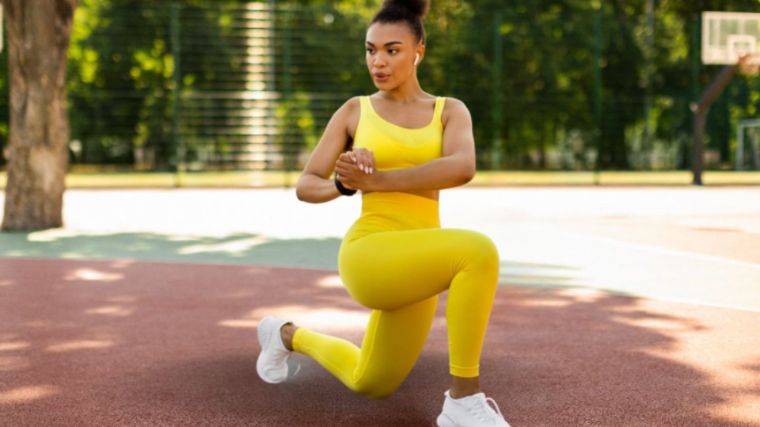
With the curtsy lunge, the extra stretch and time under tension you’ll be adding to your reverse lunge is a sure way to The curtsy lunge will add a bit more length to your repetitions and bring some hotly anticipated gains along with it. For even more glute gains on your next leg day, the curtsy lunge would like to make your acquaintance.
Table of Contents
- How to Do the Curtsy Lunge
- Curtsy Lunge Variations
- Curtsy Lunge Alternatives
- Curtsy Lunge Tips
- Benefits of the Curtsy Lunge
- Muscles Worked by the Curtsy Lunge
- Who Should Do the Curtsy Lunge
- Common Curtsy Lunge Mistakes
- Frequently Asked Questions
Editor’s Note: The content on BarBend is meant to be informative in nature, but it should not be taken as medical advice. When starting a new training regimen and/or diet, it is always a good idea to consult a trusted medical professional. We are not a medical resource. The opinions and articles on this site are not intended for use as diagnosis, prevention, and/or treatment of health problems. They are not substitutes for consulting a qualified medical professional.
How to Do the Curtsy Lunge
The curtsy lunge builds off of the core skill of a reverse lunge. You won’t need anything but your body weight — and a good sense of balance — to do it. When you’re ready, you might also grab a kettlebell or dumbbell to progress to exercise. Here’s how to get it done.
Step 1 — The Set Up

The curtsy lunge starts in a standing position with your hands together and held at your chest. You can also hold a dumbbell or kettlebell in the goblet squat position. Assume a hip-width stance with your toes pointed straight ahead. Your torso, hips, and knees should all be stacked over your midfoot.
Step 2 — Brace
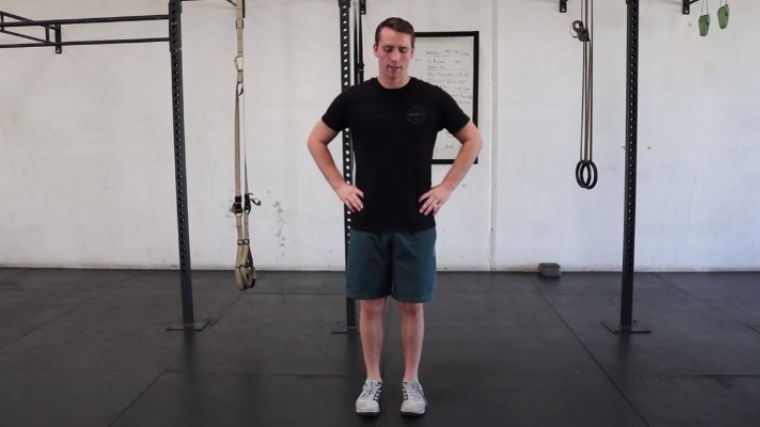
A proper brace will help you stay under control during the curtsy lunge. Subtly breathe out your air through pursed lips to help align your torso over your hips. Aim to feel your abdominal muscles tightening as you do this. While keeping even foot pressure, flex your quadriceps and glutes and engage your core. This will be your braced starting position.
Step 3 — Step Back
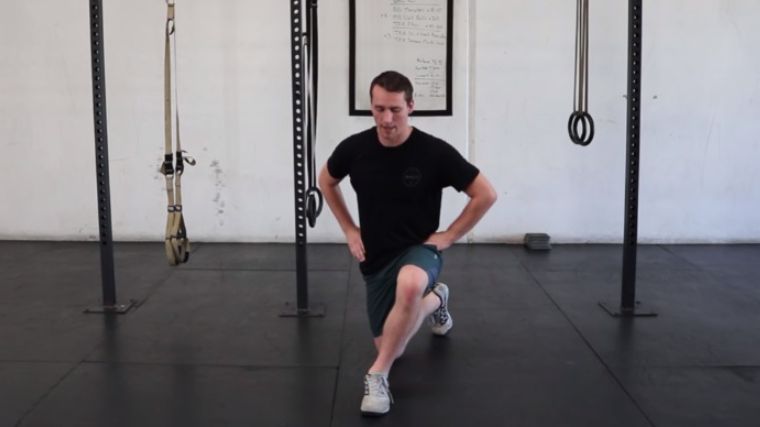
Once you’re properly braced, take a step back to perform the classic reverse lunge. You should aim to step back far enough with your back leg that your working leg hits an approximately 90-degree angle at the knee. As you step back, take a subtle but deliberate shift into your working hip by sending the back leg slightly behind your body — as though you were performing a curtsy.
Note: Your back leg does not need to shift behind your body very far. The goal is to create a deep stretch across the working hip. This means your back leg will likely land single-file behind your lead leg or slightly further.
Step 4 — Stand Up
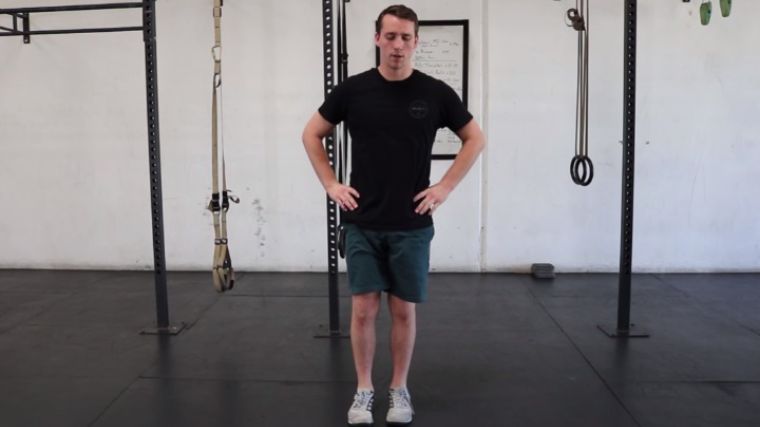
Once you’ve landed the trailing leg in the curtsy position either in line with your working leg or slightly beyond it, stabilize and start to stand back up. Maintain full foot pressure (evenly split between your heel and the ball of your foot). Drive through your quad and glute to stand up. Bring your trailing leg back to the starting position and repeat for repetitions.
Note: You can complete your set of curtsy lunges on one leg fully before swapping or you can alternate between each repetition.
Curtsy Lunge Variations
The curtsy lunge can be a challenging variation all on its own. Here are some scalable options to meet your training needs.
Assisted Curtsy Lunge
The assisted curtsy lunge is a clever way to build your skill in the curtsy lunge without throwing you under full body weight or loaded variations if you’re not ready.
[Read More: Nutrition for Athletes — How to Eat for Muscle and Performance]
Simply grab two dowels and hold them alongside your body, driving them into the ground while you work. Perform your curtsy lunges while holding the dowels as a point of stability to build your skill, balance, or strength before advancing. You can also hold onto TRX suspension straps and use your upper body to assist with stability and standing strength.
Goblet Curtsy Lunge
The goblet curtsy lunge offers a loadable option for you to integrate into your program. Since you will be rotating somewhat during the curtsy lunge, it can be difficult to find safe or effective methods of adding resistance — the goblet position is the best solution here.
Grab a dumbbell and hold it against your chest the way you would during a goblet squat. Perform the curtsy lunge as normal, this time with added load to keep gaining strength and muscle.
Deficit Curtsy Lunge
The deficit curtsy lunge adds an even bigger increase in your range of motion by standing your working leg on a small platform. This only needs to be a few inches — the height of a plate works great here. Just make sure there’s enough traction to stay stable.
[Read More: The 8 Best Knee Sleeves You Can Buy (Spring 2023 Update)]
Perform your curtsy lunge as normal, with a slightly deeper depth per repetition as a result of your heightened starting position.
Curtsy Lunge Alternatives
If you’re still working towards a curtsy lunge or would like some alternatives with similar benefits, search no further than the step-up, reverse lunge, or single-leg Romanian deadlift.
Step-Up
The step-up will bring a lot of the glute gains that a curtsy lunge will, but it offers a slightly more stable execution. You’ll perform the step-up by finding a platform with a height high enough to allow your working leg to get to about 90 degrees at the knee (or a bit more) in the starting position.
The starting position of the step-up will be very similar to the curtsy lunge, but you’ll subtract the rotational aspect. In this way, it can be a great alternative when you’re lacking the stability to perform the curtsy lunge just yet.
Reverse Lunge
The reverse lunge will help build up your dynamic stability in a similar movement pattern as the curtsy lunge. But, this alternative eliminates that final twist of the curtsy position.
The reverse lunge can be a great teaching tool to build towards the curtsy lunge, targeting similar muscles and adding in a dynamic unilateral challenge. But, it stops just shy of the final trait that makes the curtsy lunge unique.
Single-Leg Romanian Deadlift
The single-leg Romanian deadlift uses a hinge pattern as opposed to a lunge pattern to achieve many of the same benefits. This move can help build your glutes, hip stability, and coordination.
Use either a wall, dowel, or B-stance, you can customize the single-leg Romanian deadlift to your needs. You’ll perform a Romanian deadlift, but let one leg drift back behind you so that only one of your legs is working to steady your body and the weight.
Curtsy Lunge Tips
The curtsy lunge may seem simple, but that simplicity brings a broad range of applications to your program.
- For Muscle Growth: Aim for three sets of eight to 12 repetitions per leg with 90 seconds of rest for muscle growth. Hold a dumbbell in the goblet position to help load the curtsy lunge.
- For Endurance: To build muscle endurance, perform three to four sets of 15 to 20 repetitions per leg with 30 to 45 seconds of rest.
- For Warming Up: To use the curtsy lunge to warm up the lower body, perform two to three sets of eight to 10 repetitions with a pause at the bottom of each repetition. Rest for about one minute between sets and keep the load light to moderate.
Benefits of the Curtsy Lunge
The major benefits of the curtsy lunge are all about gaining muscle, improving hip mobility, and balancing out your leg development.
Muscle Gain
One major reason to perform almost any lunge variation is muscle growth, and the curtsy lunge is no different.
It brings an added hypertrophy benefit by increasing the range of motion for your gluteus maximus. With that increased range of motion, you’ll be maximizing your time under tension — a recipe for muscle gain.
Hip Mobility
It isn’t uncommon for your hips to get tight throughout the day or even from working out. The curtsy lunge can help to gain and maintain a solid degree of hip mobility. Each repetition produces a deep stretch in your hip and mobilizes the glute muscles themselves.
Be cognizant about staying within ranges of motion you can control. It won’t help to force yourself into a deeper position than you can navigate safely and in control. Aim for a light stretch sensation to improve your hip mobility with the curtsy lunge, and it will increase over time.
Balanced Legs
Unilateral exercises — focusing on one side of your body at a time — is challenging, to say the least. That’s because unilateral training breaks down the exercise into individual limbs. In this case, the front leg will perform one type of work while the back leg performs another.
In dividing up the work evenly, you’re getting an equal dose of stimulation for growth to combat any strength or muscle imbalances that may emerge from training or side dominance. But it goes beyond strength, too. You’ll be keeping tabs on mobility, stability, and all other aspects of development.
Muscles Worked by the Curtsy Lunge
The curtsy lunge hits a ton of muscle mass, including your glutes, quadriceps, adductors, and core muscles. Here’s how it breaks down.
- Glutes: The glutes are going to be one of the major players during the curtsy lunge. The rotational aspect of the curtsy lunge helps to give the gluteus maximus the greatest range of motion possible.
- Quadriceps: The quadriceps are a second huge muscle group that will help you perform the lifting aspect of the curtsy lunge. When you’re standing up, the quadriceps and glutes will tag team your knee extension and hip extension duties.
- Adductors: Your adductors (located on your inner thighs) help you bring your leg closer to the middle of your body. They also help with hip extension and pelvis stability. The deeper your range of motion during the curtsy lunge, there’s likely going to be more adductors helping you out.
- Core: The core in the curtsy lunge is going to be a combination of muscles all helping to stabilize your spine and pelvis as you move. Your abdominal muscles will help you maintain your upright posture, and your lower back, adductors, and glutes also come together to be your “core” stabilizers here.
Who Should Do the Curtsy Lunge
The curtsy lunge is a great tool for beginners, bodybuilders, and strength athletes alike.
Beginners
The curtsy lunge is one of the best bodyweight exercises you can do for both strength and hip mobility. Since you don’t need equipment or much experience to pull it off, this move is a prime candidate for integration into a beginner program.
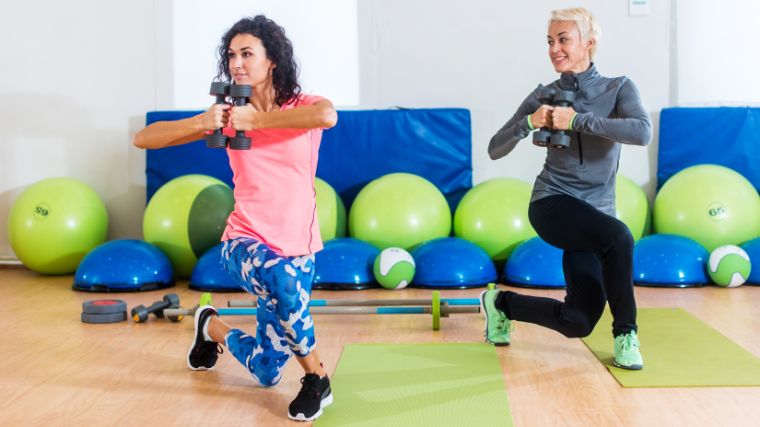
Unilateral coordination and a step-back motion tend to be easier to learn than a forward lunge style, so it can act as a muscle and stability springboard for future variations.
Bodybuilders
Physique athletes are extremely fond of chasing a pump, particularly as the last exercise of the day. Enter the curtsy lunge. On the tail end of a hard leg session, a few high-repetition rounds of curtsy lunges can help pump up the glutes without having to lean into heavy loading.
A deep stretch, higher repetitions, and single-leg emphasis are all great tools with which to end your bodybuilding session.
Strength Athletes
Mobility and stability are enormously important for strength athletes of all types — from powerlifters and strongman athletes to CrossFitters and weightlifters. The curtsy lunge can be a humbling experience for athletes in any sport, at any level.
The real benefit comes from the low-to-no load mobility and stability challenge. After a hard day under some heavy barbells, or as a part of a warm-up flow, the curtsy lunge can be a great tool for keeping the hips moving well. That’s essential for any strength sport.
Common Curtsy Lunge Mistakes
The curtsy lunge seems straightforward, but some common errors might derail your performance. Try not to “over-curtsy,” keep your brace tight, and maintain proper foot pressure.
Over-Curtsy
The curtsy lunge is recognizable by the back leg trailing behind the body, landing in line with the working leg or even slightly beyond it. However, while some is good, more is not necessarily better. One common error is overstepping the curtsy distance.

[Read More: The Best Fitness Apps]
While it may feel like you’re getting a deeper stretch, there is only so much your hip itself can handle before some other part of your body will begin to compensate. To keep your working leg benefiting from the curtsy position, lock your torso and make sure you’re not overdoing your curtsy.
Brace
Maintaining a strong brace is important to keep your balance throughout the dynamic motion of a curtsy lunge. It also helps keep your glutes working as a heavy lifter. Many muscles surrounding your midsection will work in unison to keep your spine stable.
Particularly when your core brace is loose or you’re out of position, your glutes might be acting to stabilize more than you’d like. Keep your core brace stacked and tight to make sure your glutes can focus on lifting.
Foot Pressure
For most lifts, you want to keep even foot pressure with your body weight distributed over the ball of your foot and heel. You’ll attempt to avoid losing ground contact with your arch or lateral side.
The curtsy lunge is no different. However, the curtsy lunge will add an extra challenge to your foot pressure because of the twisting motion of the exercise. With this in mind, let your curtsy position be dictated by how easily you can maintain even foot pressure.
Take a Bow
The curtsy lunge stands out as a piece of the puzzle that can round out your leg day picture. It’s easy to execute, can help with mobility and stability, and fits nicely into many parts of your routine — from warm-up to finisher.
Remember to stay diligent about execution, keeping your balance, and not overshooting your curtsy. You’ll be graced with gains in no time.
FAQs
The curtsy lunge isn’t the best-known move in the gym. If you’ve still got questions, we’ve got answers.
Is the curtsy lunge safe?
The curtsy lunge is safe when executed with diligence. Like all resistance exercises, one could get hurt. However, the curtsy lunge is no more risky than any other exercise.
The main thing to keep in mind when performing the curtsy lunge is to stay braced, control your range of motion, and don’t overdo the rotation aspect. That will help manage injury risk.
Where in my workout should I place my curtsy lunge?
This move is a unilateral exercise, it is hard to load heavily, and takes advantage of a deep stretch.
All three of these considerations push you towards placing the curtsy lunge deeper into your workout, where it can still be challenging but not impossible. Try placing it toward the end of your leg day to keep it as effective as possible for as long as possible.
Alternatively, if you have a bit more experience and can safely perform a bodyweight version of this move, add it into your warm-up. That way, you can use it to lubricate your joints and activate your muscles all at the same time.
How can I progress the curtsy lunge?
There are some progressions to the curtsy lunge like the deficit variation. You can also load up some weight in the same way you’ll load a bodyweight squat with a dumbbell to turn it into a goblet squat.
But there is a limit to how much you’ll be able to load this lift. So, apply the other principles of progressive overload to keep growing. Consider reducing rest periods or adding additional sets to your workout before (or after) loading it up.
Featured Image: Prostock-studio / Shutterstock